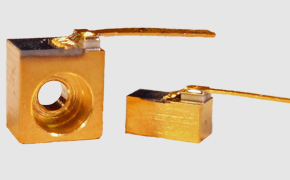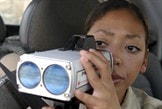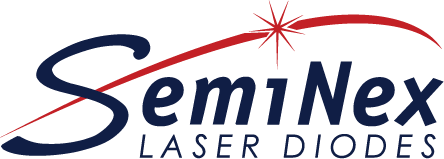Classified as “retina-safe,” laser devices integrating 1550nm wavelengths are becoming more widely used in consumer and industrial applications.
SEMINEX PRODUCT OFFERINGS AT 1550NM
SemiNex provides diode lasers with wavelengths of 1550nm in a variety of systems. The 1550nm wavelength, with a myriad of useful applications, is one of the most common lasers sold by SemiNex. 1550 nm diodes can be mounted on a B-Mount, C-Mount, as a Chip on Submount, or sold as individual Chips and Bars. Diodes can also be purchased in our High Heat Load or 4-Pin packages, or in our Multi-Chip Module. Our patented Laser Engine can also be equipped with a 1550nm laser. Click here to view all products sold at 1550nm.

TELECOMMUNICATIONS
1550nm (sometimes represented as 1.55µm) is one of three “optical windows” in optical fiber. These optical windows – whose centers are at the wavelengths 850nm, 1300nm and 1550nm – are where the optical fiber is most transparent, and thus most efficient for transmission. Those familiar with telecommunications identify the 1550 band as the “C band”. Most communication fiber installed has excellent transmission properties at 1550.
| Band | Description | Wavelength Range |
|---|---|---|
| O band | original | 1260 to 1360 nm |
| E band | extended | 1360 to 1460 nm |
| S band | short wavelengths | 1460 to 1530 nm |
| C band | conventional | 1530 to 1565 nm |
| L band | long wavelengths | 1565 to 1625 nm |
| U band | ultralong wavelengths | 1625 to 1675 nm |
In the telecommunications field, laser diodes are used to both transmit data signals (transport channel), and to test the fiber to ensure there are no breaks or significant power losses along the length of the fiber. Due to the high power of SemiNex lasers our devices are most often used in testing systems such as OTDR (optical domain reflectometry).
FREE SPACE OPTICS
In some applications the installation of new fiber is extremely difficult, impossible or just expensive. For example, in certain high rise cities organizations wish to install a secure network between buildings without utilizing the public utility. In other applications such as satellite to satellite communications the laying off fiber is not an option. For these situations the only option is the utilization of free space communications. Here-to-for this has always been done through radio waves. Transmitting data optically is superior to radio wave transmission due to its low beam divergence and faster modulation rate. Additionally free space communications is based on line-of-sight and is very difficult to intercept. 1550nm also has excellent transmission characteristics in the water absorption peaks and is an excellent choice for this application.
LIDAR APPLICATIONS
As in Free Space Optical Communications, 1550nm laser diodes are gaining market traction in  the LiDAR market. LiDAR is a morphed word which comes from “Light Radar”. It is a common application used to measure distance based on time of flight calculations. Emitted laser pulses are bounce off an object and return to a detector. Based on the round trip time one can calculate distances. In recent years high tech companies have begun building systems that build “point clouds” based on millions of measurements. When these point clouds are combined with visual images one can receive a true three dimensional map of the interested area.
the LiDAR market. LiDAR is a morphed word which comes from “Light Radar”. It is a common application used to measure distance based on time of flight calculations. Emitted laser pulses are bounce off an object and return to a detector. Based on the round trip time one can calculate distances. In recent years high tech companies have begun building systems that build “point clouds” based on millions of measurements. When these point clouds are combined with visual images one can receive a true three dimensional map of the interested area.
The LiDAR market is expected to grow significantly over the next decade as new technologies are discovered on an on-going basis. It will be used in applications as diverse as docking with the International Space Station, forensics, dental implants and autonomous vehicles. 1550 nm is the ideal wavelength of choice due to its eye safe nature at high power. These high power lasers give users higher fidelity, longer distances and more acurate results than any other option.
RANGEFINDING
Rangefinder systems are increasingly being built with 1550nm laser diodes due to the relative retinal safety at this wavelength. 1550nm lasers are considered “eye safe” at much higher power levels than traditionally used 850nm lasers. They are commonly selected for military applications because unlike the shorter 1000nm infrared laser, light at 1550nm is not visible in night vision goggles.
COSMETIC NONABLATIVE PROCEDURES
Laser diodes at 1550 nm are also used in cosmetic procedures, including non ablative laser treatments. Frequently, laser treatments consist of fractional laser resurfacing, where the laser light is fragmented into tiny bits and not blanketed over the entire surface of the skin. Only targeted segments are affected with each treatment, leading to significantly quicker treatment recovery time. Such treatments can be used to reduce scarring and post inflammatory erythema (PIE) – the latter frequently the result of inflammatory acne. Additional uses include wrinkle reduction and age spot treatment.
Visit the 1550 nm Product Finder for more information on SemiNex’s product offerings in this wavelength, and detailed information about each product. To request a quote or to find out more about our products, visit our Customer Service Page.
